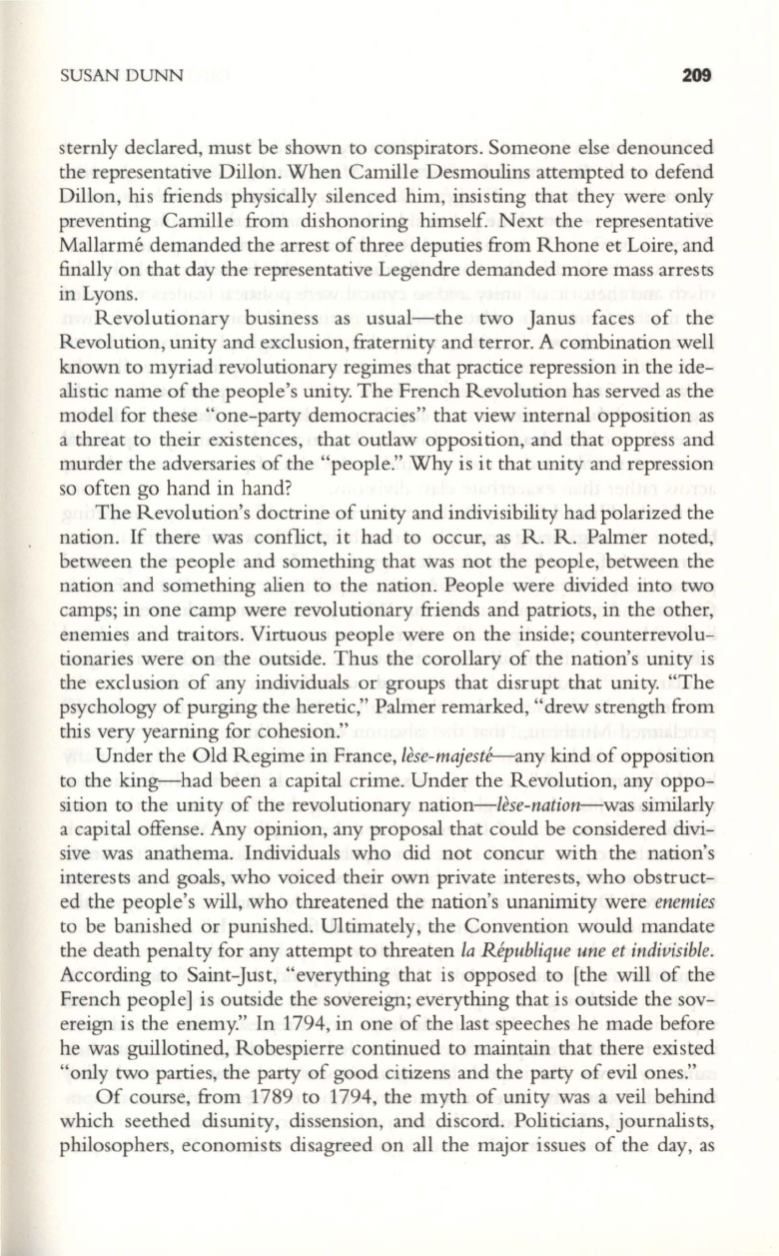
SUSAN DUNN
209
sternly declared, must be shown to conspirators. Someone else denounced
the representative Dillon. When Camille Desmoulins attempted to defend
Dillon, his friends physically silenced him, insisting that they were only
preventing Camille from dishonoring himself. Next the representative
Mallarme demanded the arrest of three deputies from Rhone et Loire, and
finally on that day the representative Legendre demanded more mass arrests
in Lyons.
Revolutionary business as usual-the two Janus faces of the
Revolution, unity and exclusion, fraternity and terror. A combination well
known to myriad revolutionary regimes that practice repression in the ide–
alistic name of the people's unity. The French Revolution has served as the
model for these "one-party democracies" that view internal opposition as
a threat to their existences, that outlaw opposition, and that oppress and
murder the adversaries of the "people." Why is it that unity and repression
so often go hand in hand?
The Revolution's doctrine of unity and indivisibility had polarized the
nation. If there was conflict, it had to occur, as R. R. Palmer noted,
between the people and something that was not the people, between the
nation and something alien to the nation. People were divided into two
camps; in one camp were revolutionary friends and patriots, in the other,
enemies and traitors. Virtuous people were on the inside; counterrevolu–
tionaries were on the outside. Thus the corollary of the nation's unity is
the exclusion of any individuals or groups that disrupt that unity. "The
psychology of purging the heretic," Palmer remarked, "drew strength from
this very yearning for cohesion."
Under the Old Regime in France,
lese-majeste--any
kind of opposition
to the king-had been a capital crime. Under the Revolution, any oppo–
sition to the unity of the revolutionary nation-lese-nation-was similarly
a capital offense. Any opinion, any proposal that could be considered divi–
sive was anathema. Individuals who did not concur with the nation's
interests and goals, who voiced their own private interests, who obstruct–
ed the people's will, who threatened the nation's unanimity were
enemies
to be banished or punished. Ultimately, the Convention would mandate
the death penalty for any attempt to threaten
la Republique une et indivisible.
According to Saint-Just, "everything that is opposed to [the will of the
French people] is outside the sovereign; everything that is outside the sov–
ereign is the enemy." In 1794, in one of the last speeches he made before
he was guillotined, Robespierre continued to maintain that there existed
"only two parties, the party of good citizens and the party of evil ones."
Of course, from 1789 to 1794, the myth of unity was a veil behind
which seethed disunity, dissension, and discord. Politicians, journalists,
philosophers, economists disagreed on all the major issues of the day, as


